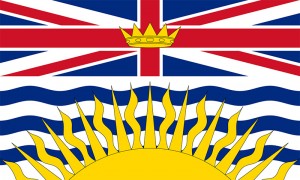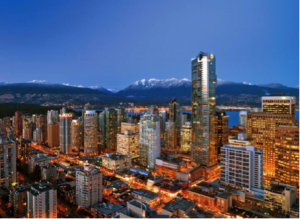According to calculation estimates, the population of British Columbia is 4,606,451.
Currently, British Columbia’s population makes up approximately 13.2% of the Canadian national population. Despite the 7.0% population growth Quebec has seen over the past years, British Columbia is the third most populated Canadian province. (Quebec is the second most populated province in Canada, while Ontario is the most populated province.)
British Columbia Land Area
The land area is 944,735 km^2, or 357,216 mi^2, making British Columbia the third largest province by land mass. British Columbia’s rugged coastline stretches for more than 27,000 km. This includes the recluse, mountainous fjords and about six thousand islands, most of which are uninhabited.
British Columbia makes up approximately 9.5% of Canada’s entire area and has a water area of 19,549 km^2, or 7,548 mi^2. It is the 5th biggest province in Canada, after Nunavut, Quebec, Northwest Territories, and Ontario.
Quebec Borders
The west side of British Columbia is bordered by the Pacific Ocean and parts of Alaska border the province from the north to northwest parts. North of British Columbia are the Yukon and Northwest Territories. East of British Columbia is Alberta province, and the south of British Columbia is bordered by U.S. states Montana, Idaho, and Washington. The southern border was established by the 1846 Oregon Treaty. The British Columbia coasts and southern part has many valleys with mild weather, but a majority of British Columbia experiences cold to subartic climate temperatures and typical Canadian winters.
The capital of British Columbia is Victoria, named after Canada’s Queen of Confederation. Victoria is located on the southeastern tip of Vancouver Island. Victoria’s population is second-largest in British Columbia, with 344,615.
British Columbia’s largest city is Vancouver, which is actually NOT located on Vancouver Island, but on the southwest corner of the mainland (also known as the Lower Mainland), with a population of 2,313,328. For five years, Vancouver has been consistently named as part of the top-ten “world’s most livable cities.” Vancouver is also home to Port Metro Vancouver, which is the busiest and largest port in Canada. Vancouver is nicknamed “Hollywood North,” as it is one of the largest film production centers in North America (see section Economic Statistics for more info). In addition, Vancouver has been the host of the 2010 Winter Olympics and the 2010 Winter Paralympics due to its proximity to Whistler Valley, a ski resort about 80 miles from the city. Recently, Vancouver has been named the 2015 FIFA Women’s World Cup host.
British Columbia Federal Representation
British Columbia holds 36 of the 308 House of Commons seats, thus making up 11.7% of the total percentage.
British Columbia holds 6 of the 105 Senate Seats making up 5.7% of the total.
British Columbia Demographics
Of the provinces, British Columbia had the highest proportion of minorities (~24.8%). In addition, Vancouver is one of the most ethnically and linguistically diverse cities in Canada; 52% of its residents do not speak English as their first language.
Ethnic Origins
- English – pop. 1,207,245 (29.6%)
- Scottish – pop. 828,145 (20.7%)
- Canadian – pop. 720,200 (17.7%)
- Irish – pop. 618,120 (15.2%)
- German – pop. 561,570 (13.8%)
- Chinese – pop. 432,435 (10.6%)
- French – pop. 361,215 (8.9%)
- South Asian – pop. 232,370 (5.7%)
- North American Indian – pop. 193,060 (4.7%)
British Columbia Economic Statistics
British Columbia is centered primarily on the forestry industry as well as an increasing interest in mining. The economy is influenced by the mining industry, but this has lead to fluctuating economic activity due to changes in commodity pricing over time. In addition, there have been economic issues concerning environmental protection, which has lead to a decreased prevalence of the mining industry in the area. Another primary industry is film/tourism; the Vancouver region in British Columbia is the 3rd largest film production location in North America, after Los Angeles and New York City, earning Vancouver the nickname, “Hollywood North.”
British Columbia’s GDP is the fourth largest in Canada at $197.93 billion in 2008. Quebec’s economy makes up approximately 12% of the total gross domestic product of Canada. The economy has primarily been driven the amount of natural resources in the area as well as the tourism element. British Columbia’s total debt will rise 16% to $47.8 billion in the 2010-11 fiscal year, or 24.3% of the total GDP.
British Columbia Historical Population Statistics
| Year | Population |
| 1851 | 55,000 |
| 1861 | 51,524 |
| 1871 | 36,247 |
| 1881 | 49,459 |
| 1891 | 98,173 |
| 1901 | 178,657 |
| 1911 | 524,582 |
| 1921 | 524,582 |
| 1931 | 694,263 |
| 1941 | 817,861 |
| 1951 | 1,165,210 |
| 1961 | 1,629,082 |
| 1971 | 2,184,620 |
| 1981 | 2,744,467 |
| 1991 | 3,282,061 |
| 1996 | 3,724,500 |
| 2001 | 3,907,738 |
| 2006 | 4,113,487 |
| 2011 | 4,400,057 |
Interactive Canadian Province Population Map
Other Resources
To learn more about the population of British Columbia, click here
Learn more about Nova Scotia Population




